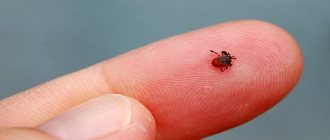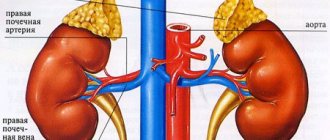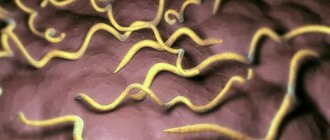What is venereal sarcoma in dogs?
The cells of this connective tissue tumor are constantly dividing, as a result of which it constantly grows, increasing in size as long as the pet lives. Veterinarians also call sarcoma of the external genitalia in animals granuloma venereum, canine condyloma, and transmissible reticuloendothelial tumor. Moreover, any dog can become infected, regardless of breed. However, in some areas such a disease may be rare, while in others, on the contrary, it is quite common.
Venereal sarcoma in dogs: causes
Symptoms of this disease begin to appear only 3-6 months after infection. Today it has been established that transmissible sarcoma is transmitted from one dog to another through sexual contact. In other words, during physical contact, histiocytic macrophage cells infect a healthy pet.
In this case, tumor cells act as infectious agents. Reproducing on the body of one animal, the allograft penetrates the tissues of another and continues to develop in a new biological environment, losing contact with the previous host. In this case, the tumor conglomerate behaves like a parasitic organism.
In cells affected by transmissible sarcoma, the composition of chromosomes changes. Instead of the required 78, only 57-64 remain in epithelial cells.
Russian experts are confident that venereal sarcoma in dogs does not metastasize, and the formation of a tumor on the face and mouth is explained by the transfer of infected cells from the genitals during licking. But foreign veterinarians think differently. They state that sarcoma metastasizes in approximately 5% of cases to the subcutaneous tissues, lymph nodes, liver, spleen, muscles, brain, eyes and testicles.
What is venereal sarcoma
The disease occurs exclusively in representatives of the canine tribe and affects animals on all continents.
The infection is transmitted sexually and affects areas of the mucous membrane, leading to the development of pathological macrophage cells that parasitize the cells of the animal. Developing like a standard malignant neoplasm, venereal sarcoma, meanwhile, is radically different from ordinary cancer. The thing is that during sexual intercourse, sarcoma cells are separated from the host’s tissues and migrate to the partner’s mucosa, completely calmly taking root and growing in a new place. This combines pathogens with parasites that can develop in any favorable environment. According to updated data, the causative agent of the disease appeared and mutated 11 thousand years ago, during the period of primary domestication of dogs. As one of the most ancient cell cultures, infectious agents store the genome of the first domesticated dogs to be infected.
Symptoms
In most cases, infection with sarcoma occurs sexually, but there are often cases when the disease develops on the mucous membranes of the nose and mouth in dogs that have sniffed or licked fresh discharge from sick animals.
Before the first symptoms of the disease appear, 2 to 9 months pass, during which the infectious agent penetrates the host cells, degenerating the mucosal tissue. Here are the main signs that your four-legged friend has contracted a dangerous disease:
- Discharge of blood from the genitals. Bloody discharge is observed from the prepuce in a male dog and from the vagina in a female dog, which does not stop for a long time. This is especially noticeable during urination, when the first portion of urine turns red. Gradually, in the process of tissue erosion by tumor cells, bleeding increases due to the destruction of capillaries, and then larger vessels.
- The appearance of small reddish papules on the mucous membrane, gradually growing in width and taking on the appearance of cauliflower.
- Urinary retention. If the tumor grows strongly and blocks the urethra, there is difficulty in excreting urine in the animal.
- If pathological cells enter the nasal mucosa, difficulty breathing, sneezing, and nosebleeds may occur.
- If malignant agents have affected the oral mucosa, an increase in the submandibular lymph nodes and swelling of the muzzle are observed. On examination, a cabbage-shaped neoplasm is observed in the mouth.
The main insidiousness of the disease is that at the primary stage, sarcoma does not cause any inconvenience to the dog and does not cause pain. Bleeding and discomfort occur when the process is advanced and there is deep ulceration of the mucous membrane.
Most often, the tumor is local in nature, but in approximately 30% of cases, if the body’s immune index is low, metastasis to nearby tissues and internal organs is possible.
Diagnostics
To make a correct diagnosis, a doctor needs only a visual examination of the animal. At the moment of vivid manifestation, clinical signs, as a rule, are expressed quite characteristically.
To make a final verdict, the doctor can conduct a cytological examination, during which a puncture biopsy or smears are taken from the affected area.
In order to exclude the occurrence of metastases, the doctor may suggest that owners conduct an ultrasound examination of the abdominal cavity.
The main condition for a quick and complete cure is early diagnosis of the disease. The faster the pathology is identified, the higher the likelihood of complete recovery and the absence of metastases.
Treatment
Just 20 years ago, the main treatment for this disease was surgery. However, now veterinarians are in no hurry to use a scalpel, talking about the high likelihood of possible complications after surgery. In addition, it is impossible to guarantee, due to the inconvenient location, complete excision of the affected tissue.
The main treatment method today is chemotherapy, in particular the herbal drug vincristine. Sometimes, if the case is advanced, cyclophosphate and methotrexate are added to the therapeutic regimen to enhance the effect.
A course of chemotherapy guarantees a complete cure, however, the dosage and timing of drug administration should be scrupulously adhered to. Just one remaining tumor cell guarantees the development of a relapse in the near future.
The best way to deal with any pathology is to prevent your dog from getting sick. What should be done to protect your pet from infection as much as possible?
- Elimination of uncontrolled matings. The main carrier of the disease was and remains stray dogs. Moreover, the tumor is equally often diagnosed in both males and females living on the street. The risk group primarily includes male domestic dogs, which compassionate owners let out for a walk in order to reduce sexual tension. In addition, the disease can also be contracted by a bitch that runs away from its owner during a period of heat and is mated to a stray male.
- Disinfection. If unwanted sexual contact does occur, we recommend syringing the female’s vagina and rinsing the male’s prepuce with miramistin and chlorhexidine. By the way, it would be nice to carry out such preventive measures during planned mating. In this case, the male's genitals are washed after intercourse, and the female's vagina - half an hour before mating.
- Health guarantee. Sexual hygiene in dogs, as in people, involves a responsible choice of partner. Nowadays, it has become a good tradition to undergo all possible tests in a timely manner, and to come to the mating already having the appropriate health certificate in hand. It would be good if the owner of the other dog participating in the breeding must provide exactly the same certificate.
- Artificial insemination. More and more owners of male dogs, concerned about the health of their pets, are practicing non-contact mating, in which the male sperm is inserted into the female’s vagina using a special device. Unfortunately, this method can only protect a male dog. In any case, the bitch remains at risk.
- Sterilization of stray dogs. In addition to sexual intercourse itself, domestic dogs can become infected simply by sniffing or licking the bloody secretions of stray dogs. Veterinarians say that malignant tumors of the nose in male dogs in most cases turn out to be venereal sarcoma.
Tumor development process
Venereal sarcoma in dogs forms about 2-6 months after infection, however, the rate of its growth varies greatly - from slow progression over several years, to rapid development with metastasis.
After infection, spontaneous regression may occur within 6 months, but if the tumor does not disappear for more than 9 months, then the chances of self-healing are reduced. The development of transmissible sarcoma in healthy pets is localized, although in some cases the disease metastasizes to the lymph nodes, subcutaneous tissues, spleen, bone marrow, eyes, oral mucosa and liver.
Since granuloma venereum is transmitted by sniffing, biting, and licking, it is difficult to distinguish true metastasis from development due to mechanical spread. Transmissible sarcoma is an immunogenic tumor, which is why the response of the dog's protective functions critically affects its biological behavior.
Stages of tumor development
All neoplasms have their own classification, which is formed on the basis of data on their impact on internal organs and size. At the first stage, the tumor develops on the surface of the genital organs, its size does not reach 4 cm. At the second stage, the sarcoma continues to grow, and it begins to affect the tissues of the organ.
During the third stage, the formation continues to grow and extends beyond the localization site. In this case, metastases occur in the lymph nodes. When the fourth degree occurs, the dog’s body is completely affected. This is why it is so important to seek help from a specialist in a timely manner when a tumor is detected. Timely therapy will help avoid relapses and painful treatment.
Main signs of the disease
In the early stages of development, as a rule, transmissible venereal sarcoma does not manifest itself in any way. Dogs, however, can behave restlessly. An attentive owner will immediately notice that the pet has begun to frequently ask to go to the toilet and is constantly licking the genitals.
First, a small compaction appears at the site of the sarcoma, then a growth the size of a pea forms. The tumor will continue to grow and can reach large sizes. Moreover, its shape can be varied, but usually the sarcoma is uneven and lumpy. On the surface of such a formation, blood vessels are visible, prone to bleeding and destruction.
The main symptoms of venereal sarcoma include:
- Redness and swelling of the animal's external genitalia.
- The appearance of bloody discharge not associated with estrus.
- The appearance of round, tuberous, cluster-shaped growths from gray to red-brown, up to 10 cm in size.
- Formation of compactions in the prepuce area.
- Purulent discharge from the genital fissure.
- Lengthening and protrusion of the perineum
Moreover, a tumor can occur not only on the genitals, but even in the animal’s mouth. Venereal sarcoma often forms in a dog's nose. This condyloma causes great discomfort to the pet.
Diagnostic measures
The main goal of the veterinarian in such a situation is to distinguish canine sarcoma from other pathologies. After all, a transmissible tumor can be confused with pyometra in females and prostatitis in males.
The specialist’s further actions are to detect the neoplasm. As a rule, in females the tumor grows in front of the vagina, and in males - in the area of the head of the genital organ, bulb and prepuce. Upon careful examination, you can notice that a venereal sarcoma has appeared in the dog. The baldness above the tumor is difficult to miss. Even when this formation occurs, many tumor nodes appear, which can reach 4 cm. They are soft to the touch, and when damaged they begin to bleed.
If all of the above symptoms appear, then the animal is probably sick.
What is osteosarcoma?
Bone cancer is the most common type of cancer in dogs. The disease accounts for up to 85% of malignant neoplasms in canines. The disease progresses rapidly and causes metastases early. Osteosarcoma is a malignant tumor that affects the bones of an animal. At the initial stage, the dog may experience mild pain and develop symptoms of rheumatism. Oncology can occur either against the background of existing osteomyelitis or without any prerequisites.
Veterinarians' prognosis for a favorable outcome is cautious. Much depends on how sensitive the tumor is to chemotherapy. Osteosarcoma of bone in dogs most often occurs in old age. Dogs of all breeds are susceptible to the disease, but it is more common in large animals. Osteosarcoma usually affects the bones of the extremities. The impetus for the development of oncology can be various factors, including trauma. Osteosarcoma can develop on any bone, but it most often affects a dog's paws.
Therapeutic methods
Treatment of venereal sarcoma in dogs is carried out in different ways. The most decisive method is to remove the tumor surgically. However, surgery, especially on the genitals, has many risks due to possible postoperative complications, such as the occurrence of adhesions, metastases, and damage to the urethra. That is why today such treatment is resorted to in rare cases.
Radiation is often used to eliminate this formation, since tumor vegetations of transmissible sarcoma are sensitive to such effects. Sometimes one radiotherapy procedure at a dose of 10 Gy is sufficient. It is carried out under anesthesia, which the animals tolerate well. But to perform this session you need special protective equipment, trained personnel and the necessary equipment. This is why the procedure is only available in large veterinary clinics.
Today, the main method of treating venereal tumors is chemotherapy.
Chondrosarcoma and osteosarcoma in dogs - treatment of the disease
Treatment of chondrosarcoma and osteosarcoma in dogs is aggressive. Because these tumors tend to metastasize to the lungs, it is necessary to examine the lungs before surgery. For this purpose, radiography is performed. Also, a sick dog is subject to a full examination. It consists of a blood test and a biopsy of enlarged lymph nodes.
In most cases, with osteosarcoma of the limb, complete or partial amputation is indicated. Typically, dogs tolerate this loss well and use three paws to move normally. It is worth noting that amputation rarely cures cancer. However, such an operation helps relieve pain and improve the animal’s quality of life. Nowadays, some veterinary clinics practice techniques that help preserve limbs in osteosarcoma.
In addition to surgical treatment, chemotherapy is performed. Its goal is to increase the life expectancy of dogs. Please note that chemotherapy does not affect the effectiveness of treatment. When a tumor metastasizes or a severe stage of cancer, it is possible to carry out radiation therapy, which consists of irradiating the animal. Radiotherapy is indicated for malignant lesions of the lower jaw. This is due to the presence of moderate sensitivity to such treatment.
To combat chondrosarcoma in dogs, surgical treatment is also performed. However, it does not lead to complete elimination of cancer.
Features of drug therapy
So, we discussed what the symptoms are for a disease such as venereal sarcoma in dogs. Timely treatment and diagnosis will help save animals from suffering. Chemotherapy brings excellent results. The following drugs are used:
- "Cyclophosphate".
- "Methotrexate."
- "Vincristine."
The latter drug is an alkaloid of plant origin. It can prevent the division of pathological cells. As a rule, the drug is effective in 95% of cases, especially in combination with other complex chemotherapy drugs.
The duration of treatment is at least 4 procedures. The drug is stopped when the pathological process completely resolves itself.
Types of sarcoma disease:
Connective tissue is present in all organs of the animal. The classification is based on the principle of tumor localization and the system affected by the pathological process.
The following types of carcinomas are distinguished:
How to prevent canine condyloma?
The most effective measure that will help prevent the occurrence of a tumor in a pet is the attentiveness and caution of its owners. To prevent the formation of a transmissible venereal tumor, dogs should not be allowed to walk alone. On top of that, the owner should not allow, much less approve, random matings of the animal.
Even when pairing your dog with a proven and purebred individual of the opposite sex, you must ask the owner whether his pet has had sexual contact with casual partners. If the answer is positive, you should refuse mating.
If you still cannot protect your pet from contact with a stray dog, it is better to take appropriate measures. It is imperative to disinfect the dog’s genitals and mouth with furatsilin, potassium permanganate or iodinol. If clinical signs of the disease appear, you should immediately contact a veterinarian.
In general, the prevention of this disease is a public matter. To reduce cases of infection, it is necessary to reduce the number of stray animals within one locality by sterilization. In addition, veterinary control must be carried out.
Osteosarcoma in dogs - symptoms and diagnosis
Osteosarcoma is characterized by the highest malignancy among bone tumors. Dogs of any age can experience this pathology. The average age of onset of this disease is about 8 years. The incidence of this type of cancer is not affected by the gender of the animal. Osteosarcoma in dogs is common in large breeds. We are talking about St. Bernards, Newfoundlands, Great Danes and Pyrenean mountain dogs. This disease also often affects Irish Setters and Boxers. Small dogs with this type of cancer are rare.
Typically, osteosarcoma in dogs is localized on the front legs. The hind limbs, ribs and jaws may also be involved in the pathological process. The main sign of this disease is the appearance of lameness in a healthy dog. However, in most cases, this sign goes unnoticed. As osteosarcoma progresses, swelling of the paws develops. Pressure on the tumor is accompanied by pain. Frequent fractures may occur at the site of the tumor.
X-ray examination is used to diagnose this disease. To confirm the diagnosis, it is necessary to use a biopsy followed by histological examination. It is important to remember that osteosarcoma in dogs is an aggressive cancer. It can grow into surrounding organs and metastasize.











